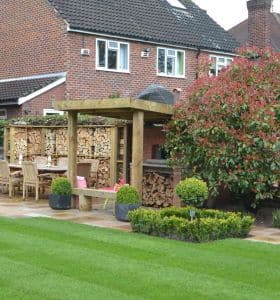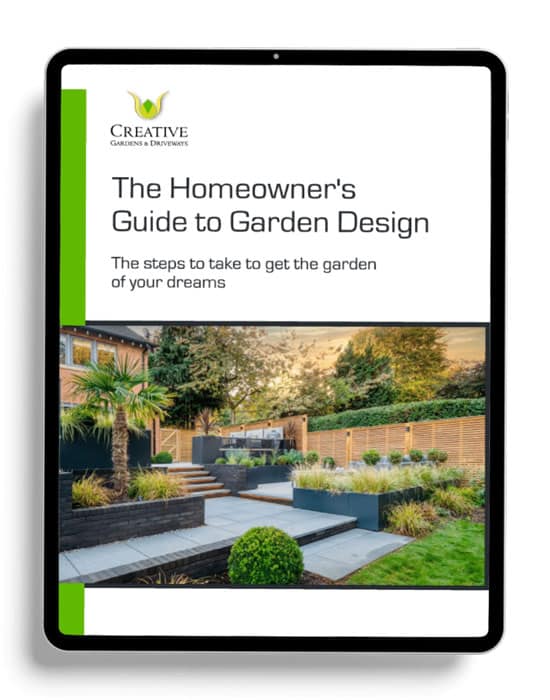
Video Transcript
Just going to run through a quick video of a question I get asked a lot, which is how much does a landscaping project cost? The simple answer is it depends. But I’m going to run through the factors that it depends upon, hopefully give you a bit more information.
Size of Area to Landscape
So one of the key aspects to cost is the size of the area that we’re landscaping. So we’ve got two projects here. One is a large garden, around about a thousand square metres.
And the one here, this is a computer visualisation of a garden we’re building at the moment, which is about a hundred square metres. So a garden that’s a thousand square meters is probably going to cost more than the one that’s a hundred.
In this particular case, this garden cost around about two hundred thousand pounds. So around about two hundred pounds a square meter. This garden will cost around about a hundred thousand for a hundred square meters. So about a thousand pounds a square meter. If we were going to do this sort of finish and this level of complexity on a large job like this, it would cost a million pounds.
Often the cost of the driveway or the budget or the investment that the client wishes to set, they sort of base on the value of the house. So, often people are spending around about 20 percent of the value of the house. In these two cases the landscaping spend is within that 20%. And it’s a bit of a rule of thumb that a lot of people apply when they’re thinking about these things.
So the cost per square metre on this large job is lower than this one because there’s areas within the garden that have a lower cost per square metre. So the lawn is a key one. There’s a big lawn here and whilst we redid the lawn and installed some drainage, the cost of the lawn is a lot less than the cost of porcelain paving and raised planters and pots, for instance.
Obviously there is paving involved in this. The other thing is the planting. So this project the planting was relatively sparse to start with. There’s a lot of herbaceous plants, which over the years have really developed and filled out the beds. But at the moment, you can see from this aerial shot that there’s quite a lot of space between the plants to allow them to grow.
So that was an area where a saving could be made. And the paths running around the garden. They’ve been done in gravel, which is quite a cost effective way of putting some hard standing into the project.
The project on the right here doesn’t have any grass. The gravel areas are minimal. So it’s all paving, decking, planters. There’s a cedar fence running around the garden. There’s these large bleach trees. Which are a significant investment each.
So everything within this small space has a relatively large cost associated with it. So there’s some information about the size of the garden, the cost per square meter and how that sort of varies and the reasons for that.
Complexity of Area to Landscape
The complexity of the garden also has a key bearing on the cost per square metre and therefore the overall cost. So sloped gardens. require retaining walls, generally, and we generally build these out of brick or steel, something that’s going to last rather than sleepers. Railway sleepers are a sort of cheap and cheerful way of building a retaining wall, but they tend to last about five years, which isn’t really long enough.
We need 15, 20 years. So a sloped site will generally cost twice as much per square meter as a simple flat site like this, like this one on the right here. So the complexity of the space is a key factor in determining how much the overall landscaping is going to cost.
The Client Brief
The client brief is also critical to the cost. So here we’ve got two sort of extreme examples on the left here. This is an area of the garden where we’ve got a lot going on. There’s a lot of paving. There’s a bespoke pergola. There’s a lot of retaining walls. There’s some really nice furniture.
There’s a stainless steel rill running through forming a water feature that there’s a lot going on. There’s some mature planting and there’s also a garden building with a kitchen, et cetera, et cetera. And this design followed the brief that the customer gave for an entertaining area and multiple levels, a lot of interest high end materials, etc.
The garden on the right was a much simpler brief. They wanted a big lawn for the grandchildren to play on that looked looked amazing with nice stripes on it and a really effective avenue of trees, which were box shaped. So you can see one garden is complex, following the client brief, the other is a lot simpler. So these things can obviously affect the cost and the investment required.
Material Choices
Material choices. I’ve got an example of pathways. There’s lots of different material choices to think about. So there’s paving, if there’s raised beds, what are they going to be made on? You know, there’s tens of choices to make for any garden.
For pathways, on the left hand side here we’ve got a gravel pathway and we use a stabilised gravel system so the gravel doesn’t go everywhere and you can walk on it easily. That’s a relatively cost effective way of covering an area and it might be 50 a square metre. On the right, we’ve got a very expensive way of covering an area which is a Victorian style tile path where each individual tile is laid onto a concrete base with a special adhesive.
That is a very labour intensive way of building a pathway. It looks amazing. And in certain situations, it’s exactly the right solution, but that will cost in excess of £1, 000 a square metre. So there’s a big difference between the two. They’re both pathways and they both serve the same function, but they look different. And very different price points.
Water Features
Water features is another example of the big variance of options. So on the left hand side here, we’ve got a koi pond. Koi ponds are generally very expensive. There’s a lot of excavation work to do around the back where you can’t see it there’s multiple filters and pumps and all sorts of stuff to keep the fish happy.
And the depth of the pond is probably twice as much as sticking out the ground. And we’ve got a window and a water feature, et cetera.
This is a much simpler water feature. It’s a rill, it’s not an entire designed to have fish in it, but the water still circulates around with a, with a pump and it’s provide a reflective surface and an interest within the garden and it’s really effective.
There’s a lot of work that goes into something even that simple. It’s got to be built out of block work. It’s got to be fiberglass. There’s got to be a pump system. There’s a lot of thought that goes into it.
Another option would be a sort of self contained water feature that the water is pumped around. This one is made out of Corten steel, a bespoke system. And on the right hand side is a large pebble with a hole drilled through it and there’s a pump and a sump underneath it.
So to get the sound of moving water, on the right hand side here, this is quite a simple but effective option. But we can go upwards from that in terms of cost and that’s very much client led in terms of the brief that’s provided and the budget that’s available.
Outdoor Kitchens
Kitchens is another thing that can be factored in. A lot of gardens now are asking for kitchens. This on the left here is a grillo kitchen and there’s quite a lot of seating area, a couple of barbecues. A lot of storage space, so that represents a reasonable investment.
On the right here, different sort of kitchen. We’ve still got a barbecue. We’ve got a fridge. We’ve got granite worktops. So both of those are reasonable investments for the householder. Much more so than just having a separate barbecue, but they’re a different thing.
Fencing
Fencing is another thing to consider. So on the left hand side here, we’ve got a really simple but well built fence. And in the middle there’s a softwood fence using Jackson’s fence panels. This is a more expensive way of doing a fence than the option on the left. But it’s got a quality finish to it and it’s a different look.
On the right hand side here, this is a bespoke hardwood fence that was specifically made for the customer to the maximum height we’re allowed to install. And that’s another price point. So there’s a significant difference between those. They’re all a fence, they all sit on the boundary and separate you from your neighbours. But obviously a very different look and price point to those.
Planting Options
Planting is the other thing. So on the left here, we’ve got a clown prune bonsai and some clipped box hedging. So, you know, these are a reasonable investment. Each of that bonsai might have been a couple of thousand pounds. If you want mature hedging, we can buy it already like that.
On the right hand side, we’ve got herbaceous planting, which looks amazing. Some of it dies off in the winter. We’ve got some shrubs to give some structure during the winter time, but per square meter, the spend of something like that is a lot less than something a lot more formal with, with large specimen trees.
Lighting
Lighting is the other thing to consider. So we generally install the sort of spotlights that are on the left hand side. So they might be 30 or 40 pounds per light for a good quality LED fixture.
On the right hand side, we’ve got a copper light fitting. Emits the same amount of light, has the same effect, but that might be two or three hundred pounds for a fitting. If you’ve got 20 within a garden, obviously the price can soon mount up.
The Design Process
So as we go through the design process, what we’re able to do is firm up the price as we go. And I’ve written a guide and that’s downloadable on our design process and how the budget price is firmed up as we go through the process.
So from an initial phone call with a client and some photos of the job, I’m able to give a reasonable indication at the sort of investment that might be involved.
Once a client brief has been taken by the designer and some rough measurements taken, we’re able to give a much more detailed estimate about what it might cost. Then the concept designs are produced and then we can give quite an accurate estimate of what it’s going to cost.
Then when we get into the detailed drawings, choosing exactly what sort of paving is going to be, what material for the fencing, how big the water feature is going to be. How big the plant is going to be, how many pots are required, what plants are going in, all those details allow us to then produce a fixed price quote for the job. And so that’s how our process works. I hope that you found the video useful.
Contact Us Today
Contact us today to discuss how we can help you design the perfect garden to suit your personality and lifestyle.








